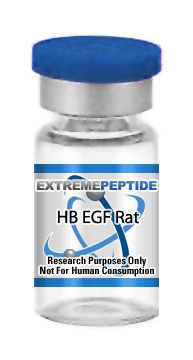(Click here to read our disclaimer)
HB EGF refers to the heparin binding form of the EGF-like growth factor that can be found in mammals. This chemical is also synthesized for use in medical research as a means of understanding how deficiencies or extreme amounts of this chemical might impact the way an animal reacts to different diseases.
This is commonly used as a means of developing a stress test for eating disorders, with scales used to determine the psychometric properties associated with varying amounts of HB EGF. This self-rating scale is commonly used to help track posttraumatic stress disorder, which has improved the effectiveness of research topics in animals within laboratory settings.
The expression of HB EGF was analyzed in rats to determine how this chemical packs a principal beta hairpin which can be expressed in a crystal structure or diphtheria toxin. Results indicate that HB EGF may act as a post-transcriptional mechanism that can be introduced in trophblasts that will amplify HB EGF, that is used by the animal’s body to inhibit apoptosis.
How HB EGF is Regulated
HB EGF cDNA was isolated in a library which focused on progesterone-induced transcripts in rat uterine stomal cells.
- This was performed to test the effects of estradiol and progesterone in the way that HB EGF is expressed in mature stomal and epithelial rat uterine cells.
- Progesterone treatment and estradiol injections were applied to each rat followed by a stimulation of HB EGF expression within the stomal cells.
The expression of HB EGF was linked as a primary response to mRNA in the stomal cells, revealing that epithelial or stomal cells in vivo that were exposed to similar hormonal conditions may induce cell proliferation. This holds true for both cell types which suggests that HB EGF could be used to mediate mitogenic effects that steroid hormones have on a rat uterus.
Post-Ischemic Administration
HB EGF has been found to be hypoxia inductible, acting as a neruoprotective protein that may stimulate proliferation of any neuronal precursor cells.
- This allows researchers to note that HB EGF could be used to aid in the recovery from cerebral injuries using direct neruoprotective effects such as enhancing enrogenesis.
- When HB EGF was administered to rats using intracerbroventricular for 103 days within the vertebral ischemia the HB EGF content of the rat’s body decreased the volume of infarcts and post-ischemic neurological deficits.
This delayed neruoprotective effect that is associated with HB EGF application in adult rats implies that this application process may aid in efforts that can prolong ‘therapeutic windows’ that could be used to intervene in the event of a stroke.
HB EGF has also been known to bind with EGFRs at a high affinity. It will also bind with sulfate proteogylcans that can result in mitogenic potential which helps to set this chemical apart from others in the same family. It has been concluded that HB EGF TM will synthesize exclusively with a luminal epithelium at blastocyst appositions. This is a juxtacrine adhesion factor that can help to mediate the adhesion of blastocysts to the uterus in some animals.
Sources:
http://endo.endojournals.org/content/134/3/1089.short
http://www.nature.com/jcbfm/journal/v24/n4/abs/9591541a.html
Click here to view our entire PDF research library
Click here to view/download the PDF version of this article
